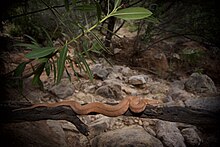Macrovipera lebetinus schweizeri
| Macrovipera lebetinus schweizeri | |
|---|---|

| |
| Red phase Macrovipera lebetinus schweizeri found in ambush on Milos, Greece. | |
| Scientific classification | |
| Domain: | Eukaryota |
| Kingdom: | Animalia |
| Phylum: | Chordata |
| Class: | Reptilia |
| Order: | Squamata |
| Suborder: | Serpentes |
| Family: | Viperidae |
| Genus: | Macrovipera |
| Species: | |
| Subspecies: | M. l. schweizeri
|
| Trinomial name | |
| Macrovipera lebetinus schweizeri (F. Werner, 1935)
| |

| |
| Synonyms[2] | |
| |
Macrovipera lebetinus schweizeri, the Milos viper, also known as the Cyclades blunt-nosed viper,[3] [4] is a subspecies of venomous snake in the family Viperidae. The subspecies is endemic to the Cyclades Archipelago of Greece in the Aegean Sea.[1][5][6]
Etymology
[edit]The subspecific name, schweizeri, is in honor of Swiss herpetologist Hans Schweizer (1891–1975).[7]

Description
[edit]Milos vipers grow to an average total length (including tail) of 50–70 cm (20–28 in), with a maximum of 98.5 cm (38.8 in).[3]
Geographic range
[edit]Milos vipers are found on the Greek islands of the Cyclades Archipelago in the Aegean Sea: Milos and the four smaller, adjacent islands of Antimilos, Siphnos, Kimolos and Poliaigos.[1][2][3] The type locality is given as "Insel Milos ".[2][5]
Biology
[edit]Feeding
[edit]Gut analysis of road killed specimens showed that adults feed on passerine birds, while young vipers under 35 cm feed primarily on Milos wall lizards and European copper skinks. This adaptation to feeding on birds and lizards likely occurred because of the lack of native rodent species in the western Cyclades (house mice and black rats were introduced). While largely terrestrial, they have seasonally arboreal behaviour, foraging for prey in trees on autumn nights.[8]
Conservation status
[edit]
This subspecies, M. l. schweizeri, is classified as endangered by the IUCN; less than 4000 adult individuals exist in the wild as of 2022.[1] Furthermore, a continuing decline is observed due to being killed by feral cats,[8] persecution and over-collecting by collectors, and its habitat continues to decline in extent and quality.[1] As of 1998, 500-600 adults were being either removed from the wild or killed per year as a result of illegal collection, road-killing, or persecution.[8]
It is also listed as strictly protected (Appendix II) under the Berne Convention.[9]
Venom
[edit]Local medical centres report that snake bites from this species occur on average once per year on Kimolos and 4 times per year on Milos, although there are no recorded fatalities.[8]
It is narrated by G.A. Boulenger in his book The Snakes of Europe that "Dr. de Bedriaga observed this much dreaded snake, the bite of which is probably as bad as that of its Indian ally, the Daboia, Vipera russelli ". It is probable that the snake he assumed was Macrovipera lebetina is in fact the Milos Viper.
References
[edit]- ^ a b c d e Wolfgang Böhme, Petros Lymberakis, Claes Andrén (2009). "Macrovipera schweizeri". IUCN Red List of Threatened Species. 2009: e.T12654A3369754. doi:10.2305/IUCN.UK.2009.RLTS.T12654A3369754.en. Retrieved 20 November 2021.
{{cite journal}}: CS1 maint: multiple names: authors list (link) - ^ a b c McDiarmid RW, Campbell JA, Touré TA (1999). Snake Species of the World: A Taxonomic and Geographic Reference, Volume 1. Washington, District of Columbia: Herpetologists' League. 511 pp. ISBN 1-893777-00-6 (series). ISBN 1-893777-01-4 (volume).
- ^ a b c Mallow D, Ludwig D, Nilson G (2003). True Vipers: Natural History and Toxinology of Old World Vipers. Malabar, Florida: Krieger Publishing Company. 359 pp. ISBN 0-89464-877-2.
- ^ Steward JW (1971). The Snakes of Europe. Cranbury, New Jersey: Associated University Press (Fairleigh Dickinson University Press). 238 pp. LCCCN 77-163307. ISBN 0-8386-1023-4.
- ^ a b Macrovipera schweizeri at the Reptarium.cz Reptile Database. Accessed 29 July 2020.
- ^ "Macrovipera schweizeri". Integrated Taxonomic Information System. Retrieved 29 July 2020.
- ^ Beolens, Bo; Watkins, Michael; Grayson, Michael (2011). The Eponym Dictionary of Reptiles. Baltimore: Johns Hopkins University Press. xiii + 296 pp. ISBN 978-1-4214-0135-5. (Macrovipera schweizeri, p. 239).
- ^ a b c d Nilson, Göran; Andrén, Claes; Ioannidis, Yiannis; Dimaki, Maria (1999). "Ecology and conservation of the Milos viper, Macrovipera schweizeri (Werner, 1935)". Amphibia-Reptilia. 20 (4): 355–375. doi:10.1163/156853899X00411. ISSN 0173-5373.
- ^ Convention on the Conservation of European Wildlife and Natural Habitats, Appendix II at Council of Europe. Accessed 9 October 2006.
Further reading
[edit]- Werner F (1935). "Reptilien der Ägäischen Inseln ". Sitzungberichte der Kaiserlichen Akademie der Wissenschaften in Wien 1244: 81–117. (Vipera lebetina schweizeri, new subspecies, p. 117). (in German).
External links
[edit]- Cyclades blunt-nosed viper (Macrovipera schweizeri) at ARKive. Accessed 26 September 2006.
- Macrovipera schweizeri at Amphibians and Reptiles of Europe. Accessed 9 October 2006.
- Macrovipera lebetinus at the Reptarium.cz Reptile Database. Accessed 9 August 2022.

